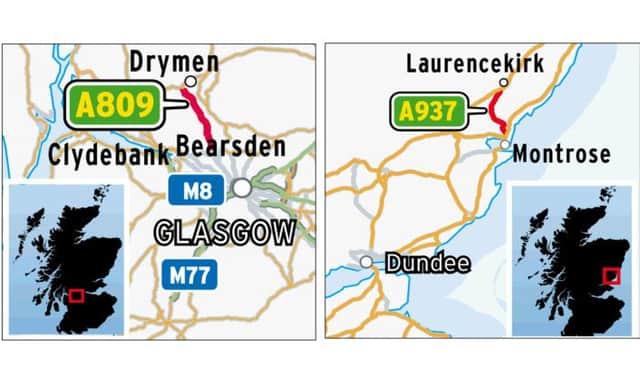Two Scottish roads among most dangerous in Britain


Despite a drop in the number of accidents on both of them, a ten-mile stretch of the A809 in Glasgow and an eight-mile section of the A937 at Montrose, Angus, came second and third in a study entitled How Safe Are You On Britain’s Roads?
The list, drawn up by the Road Safety Foundation, (RSF) rates high-risk and medium- to high-risk roads that have shown little or no change in accident levels, or which have had significant increases in the number of crashes on them.
Advertisement
Hide AdAdvertisement
Hide AdOn the stretch of road in Glasgow, from Bearsden to the Drymen area, there were 13 fatal and serious crashes between 2010 and 2012, compared with 15 between 2007 and 2009.
On the Montrose route, there were ten fatal and serious crashes between 2007 and 2009, while in the 2010 to 2012 period, there were eight.
A 12-mile stretch of road along a southern England coastal route came top of the list of persistently dangerous roads in Britain.
On the stretch of the A285 that runs between Chichester and Petworth in West Sussex, fatal and serious crashes have increased by 16 per cent between 2007 to 2012.
The study ranked the A70 route between Cumnock and Ayr as the tenth most improved route, following upgrades at junctions, bends and footways. There have also been speed limit reviews and a mobile speed camera brought in.
CONNECT WITH THE SCOTSMAN
• Subscribe to our daily newsletter (requires registration) and get the latest news, sport and business headlines delivered to your inbox every morning
Scotland, which has the UK’s highest number of single-carriageway roads, has been shown to have the third safest single carriageways in Britain, a move described by the report as “a marked improvement”.
Neil Greig, director of policy and research at the Institute of Advanced Motoring (IAM), the UK’s biggest road safety charity, said that, in the case of the A809 in Glasgow, motorcyclists were the main issue.
Advertisement
Hide AdAdvertisement
Hide Ad“It tends to be popular with motorcyclists, and when you get a lot of those on a road, it will get a high risk rating,” he said. “So on that particular road, the motorcyclist risk needs to be highlighted by the police but also in education campaigns aimed at them.”
He added: “Certainly, Road Safety Scotland will be making motorcycling a priority next year, so that will go some way towards addressing that issue, but, generally, when it comes to motorcyclists, police enforcement is the only way to make them behave.”
Mr Greig described the Montrose route as the “classic, cross-country single carriageway where most fatal accidents take place”.
The IAM chief went on: “The report points out that you can do quite a lot with fairly basic improvements, things like good white-lining, lighting at junctions, just generally tidying up the roads.”
The RSF report shows how local councils scheduling low-cost safety improvements alongside routine maintenance have helped reduce fatal and serious crashes by 80 per cent on 15 stretches of roads across Britain.
SCOTSMAN TABLET AND IPHONE APPS